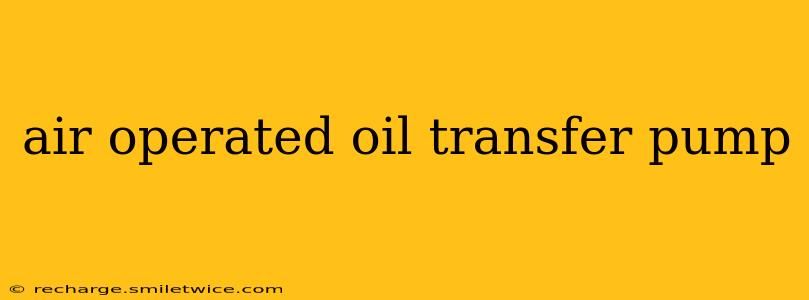Air-operated oil transfer pumps offer a robust and versatile solution for transferring various oils and fluids in a wide range of industrial and commercial applications. Their pneumatic operation eliminates the need for electrical power, making them ideal for hazardous environments or locations without readily available electricity. This comprehensive guide will delve into the specifics of these pumps, addressing common questions and highlighting their key advantages and considerations.
What are the Advantages of Air Operated Oil Transfer Pumps?
Air-operated double diaphragm pumps, a common type used for oil transfer, boast several key advantages:
- Safety: The absence of electrical components significantly reduces the risk of sparks and explosions, making them exceptionally safe for handling flammable liquids like oil.
- Portability: Their compact size and lightweight design facilitate easy transportation and setup in various locations.
- Versatility: They can handle a wide viscosity range of oils, from light to heavy, with minimal adjustments.
- Dry Run Capability: Unlike some electric pumps, air-operated pumps can run dry without damage, although prolonged dry running should be avoided.
- Ease of Maintenance: Generally, air-operated pumps require less maintenance than their electric counterparts, simplifying upkeep and minimizing downtime.
- Cost-Effective: While the initial investment might be comparable, the reduced maintenance and electricity costs can lead to significant long-term savings.
What are the Different Types of Air Operated Oil Transfer Pumps?
Several types cater to various needs and applications:
- Double Diaphragm Pumps: These are the most common type, using two diaphragms to create a pulsating flow, ideal for viscous fluids and those containing solids.
- Rotary Vane Pumps: These pumps use rotating vanes to transfer oil, suitable for lower viscosity oils and higher flow rates.
- Gear Pumps: Employing interlocking gears, these pumps are efficient for transferring cleaner oils at higher pressures.
The choice depends largely on the specific oil characteristics (viscosity, abrasiveness, contaminants), desired flow rate, and pressure requirements.
How Much Oil Can an Air Operated Oil Transfer Pump Transfer?
The transfer capacity of an air-operated oil transfer pump is highly variable and depends on several factors:
- Pump Size and Model: Larger pumps naturally have higher capacities.
- Air Pressure: Higher air pressure generally leads to increased flow rate.
- Oil Viscosity: Higher viscosity oils will result in lower transfer rates.
- Pipe Diameter and Length: Smaller diameter pipes and longer lengths will reduce the flow rate.
Manufacturers' specifications will provide the pump's theoretical maximum capacity under ideal conditions. In practice, actual transfer rates may be lower due to the factors mentioned above.
What is the Best Air Pressure for an Air Operated Oil Transfer Pump?
The optimal air pressure varies depending on the specific pump model and the oil being transferred. Consult the manufacturer's instructions for the recommended pressure range. Using excessively high pressure can damage the pump, while insufficient pressure may lead to inadequate flow. Typically, pressures range from 40 to 100 PSI, but this is just a general guideline.
How Do I Choose the Right Air Operated Oil Transfer Pump for My Needs?
Selecting the appropriate air-operated oil transfer pump involves considering these key factors:
- Oil Type and Viscosity: Determine the specific characteristics of the oil to be transferred.
- Required Flow Rate: Calculate the volume of oil that needs to be transferred per unit time.
- Pressure Requirements: Consider the pressure needed to overcome friction losses in the piping system.
- Environmental Considerations: Assess the safety requirements of the environment where the pump will be used.
- Budget: Balance cost with performance and longevity.
Maintaining Your Air Operated Oil Transfer Pump
Regular maintenance is crucial for ensuring the longevity and efficient operation of your air-operated oil transfer pump. This includes:
- Regular Inspections: Check for leaks, wear and tear, and loose connections.
- Lubrication: Follow the manufacturer's recommendations for lubrication schedules.
- Diaphragm Replacement: Diaphragms have a finite lifespan and will need replacing eventually.
- Air Filter Maintenance: A clean air filter is essential for optimal performance and to prevent damage to the pump's internal components.
By understanding these key aspects of air-operated oil transfer pumps, you can make an informed decision and ensure safe and efficient oil transfer operations. Remember always to consult the manufacturer's instructions and safety guidelines for specific details regarding your chosen pump model.
